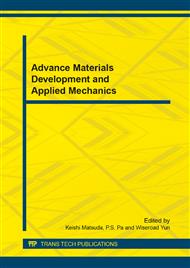[1]
J. Seitz, V. Jenkouk, G. Hirt, Manufacturing dish shaped rings on radial-axial ring rolling mills, Prod. Eng. Res. Devel., 7 (2013) 611-618.
DOI: 10.1007/s11740-013-0486-y
Google Scholar
[2]
Z.W. Wang, S.Q. Zeng, X.H. Yang, C. Cheng, The key technology and realization of virtual ring rolling, J. Mater. Process. Technol., 182 (2007) 374-381.
DOI: 10.1016/j.jmatprotec.2006.08.020
Google Scholar
[3]
X.H. Han, L. Hua, J. Lan, Z.J. Zuo, G.W. Jia, L.W. Huang, Simulation and experimental study of hot ring rolling of LD10 conical ring with inner steps, J. Wuhan Univ. Technol., 29 (2007) 7-10.
DOI: 10.4028/www.scientific.net/amr.26-28.993
Google Scholar
[4]
M. Wang, H. Yang, C. Zhang, L.G. Guo, Microstructure evolution modeling of titanium alloy large ring in hot ring rolling, Int. J. Adv. Manuf. Technol., 66 (2013) 1427-1437.
DOI: 10.1007/s00170-012-4420-9
Google Scholar
[5]
S. Zhu, H. Yang, L.G. Guo, R.J. Gu, Investigation of deformation degree and initial forming temperature dependences of microstructure in hot ring rolling of TA15 titanium alloy by multi-scale simulations, Comp. Mater. Sci., 65 (2012) 221-229.
DOI: 10.1016/j.commatsci.2012.07.014
Google Scholar
[6]
G. Zhou, L. Hua, J. Lan, D.S. Qian, FE analysis of coupled thermo-mechanical behaviors in radial–axial rolling of alloy steel large ring, Comp. Mater. Sci., 50 (2010) 65-76.
DOI: 10.1016/j.commatsci.2010.07.008
Google Scholar
[7]
Z.C. Sun, H. Yang, X.Z. Ou, Effects of process parameters on microstructural evolution during hot ring rolling of AISI 5140 steel, Comp. Mater. Sci., 49 (2010) 134-142.
DOI: 10.1016/j.commatsci.2010.04.036
Google Scholar
[8]
X. Gong, F. Yang, Research of PEEQ for Conical Ring with Outer Steps Ring Rolling, Phys. Proc., 25 (2012) 257-261.
DOI: 10.1016/j.phpro.2012.03.081
Google Scholar
[9]
H.L. Yuan, Dorctoral Dissertation for Huazhong University of Science and Technology Wuhan, China, (2006).
Google Scholar
[10]
R.S. Lee, H.C. Lin, Process design based on the deformation mechanism for the non-isothermal forging of Ti–6Al–4V alloy, J. Mater. Process. Technol., 79 (1998) 224-235.
DOI: 10.1016/s0924-0136(98)00016-8
Google Scholar
[11]
Z.M. Hu, J.W. Brooks, T.A. Dean, Experimental and theoretical analysis of deformation and microstructural evolution in the hot-die forging of titanium alloy aerofoil sections, J. Mater. Process. Technol., 88 (1999) 251-265.
DOI: 10.1016/s0924-0136(98)00407-5
Google Scholar
[12]
M. Wang, H. Yang, Z.C. Sun, L.G. Guo, Analysis of coupled mechanical and thermal behaviors in hot rolling of large rings of titanium alloy using 3D dynamic explicit FEM, J. Mater. Process. Technol., 209 (2009) 3384-3395.
DOI: 10.1016/j.jmatprotec.2008.07.054
Google Scholar


